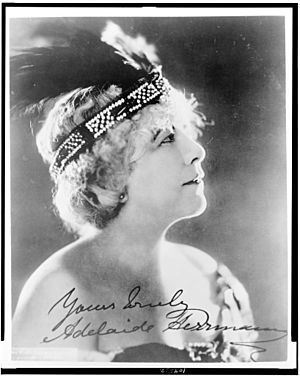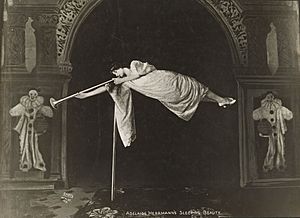Adelaide Herrmann facts for kids
Quick facts for kids
Adelaide Herrmann
|
|
|---|---|

Herrmann as Sleeping Beauty
|
|
| Born |
Adelaide Scarcez (Scarsia)
1853 London, England
|
| Died | February 19, 1932 New York, NY
|
Adelaide Herrmann (1853–1932) was a famous English magician. She was also a vaudeville performer. People called her "the Queen of Magic." She was married to Alexander Herrmann, who was also a magician.
Contents
Becoming a Magician
Adelaide Herrmann was born in London in 1853. Her original name was Adelaide Scarcez. Her father helped create the famous Egyptian Hall, a place known for magic shows.
When she was young, Adelaide learned acrobatics and dance. She also learned to ride a velocipede, which was an early type of bicycle. She even traveled as a trick-rider with a special group. In 1874, she came to New York City to work as a dancer.
Working with Alexander Herrmann
Adelaide started her magic career by helping her husband, Alexander Herrmann. They got married in 1875. Alexander was known as "Professor Herrmann" or "Herrmann the Great."
Together, Alexander and Adelaide performed many magic tricks. These included escape tricks and the bullet catch trick. Adelaide was very important in many illusions. She would pretend to float in the air or be shot from a cannon. She also rode a bicycle while carrying a girl on her shoulders. The Herrmanns traveled all over the United States, Mexico, South America, and Europe.
In 1888, the Herrmanns put on a show. They showed how a spiritualist named Ann O'Delia Diss Debar was faking her claims to talk to spirits.
Her Own Magic Show
After Alexander died in 1896, Adelaide Herrmann decided to keep the magic show going. She first worked with Alexander's nephew, Leon Herrmann. But they did not get along well. So, they stopped working together after only three seasons.
The Queen of Magic
After that, Adelaide Herrmann became very famous on her own. She earned the nickname "The Queen of Magic." She toured as a main performer for more than 25 years. She performed in many countries, including London and Paris. In 1903, she performed on Broadway in New York City. She often performed with other vaudeville acts. She was frequently mentioned in the New York Times newspaper. In 1899, she said she wanted to be known as a top magician, no matter if she was a man or a woman.
Famous Illusions
Adelaide's favorite illusion was called "The Phantom Bride." In this trick, she made a bride's body float on stage. She would pass a hoop over the floating body to show there were no wires. Then, she would pull away a silk cloth, and the bride would be gone.
In "The Witch" illusion, she would come onto the stage dressed as an old woman. She would then dive into a fire. Instead of staying gone, she would come out looking young and new.
Her "Noah's Ark" act was a huge hit in vaudeville shows. First, an empty ark was shown. Then, water was poured into its chimney. Soon, two cats would climb out. After that, a ramp would appear, and dogs dressed as different animals would walk out. White doves would fly from the windows. Finally, the ark would open to show a woman dressed in white.
Later Years
Herrmann kept performing magic into her 70s. In 1926, a big warehouse fire destroyed many of her props. Most of the animals she used in her "Noah's Ark" illusion also died. She did not give up. She quickly started a new show called "Magic, Grace and Music." This show focused on the three things she did best. She performed for one more year.
Adelaide Herrmann died from pneumonia on February 19, 1932. She is buried in Woodlawn Cemetery in New York.
See also
 In Spanish: Adelaide Herrmann para niños
In Spanish: Adelaide Herrmann para niños


